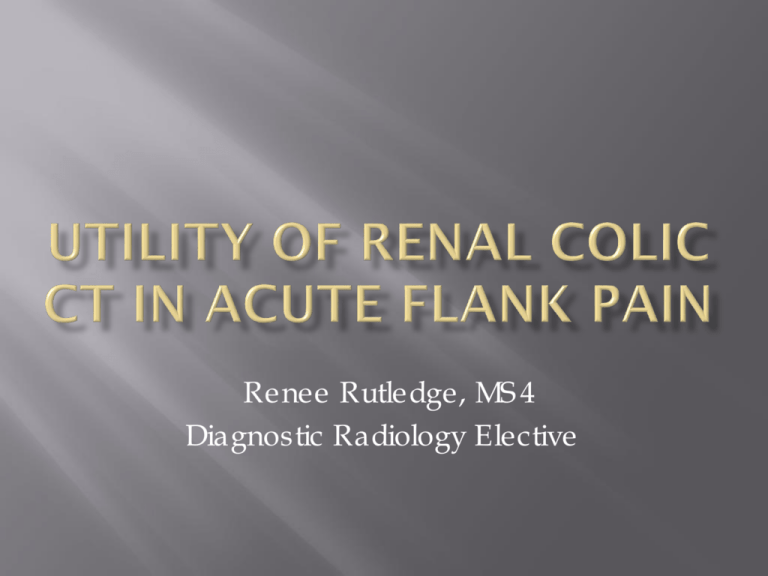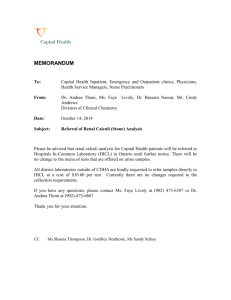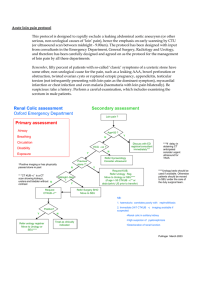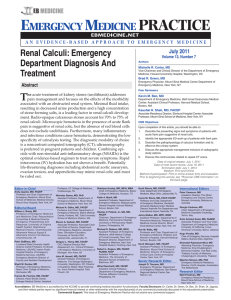Non-contrast Renal colic ct:
advertisement

Renee Rutledge, MS4 Diagnostic Radiology Elective Radiation Dose: Estimated effective dose 8.5mSv Cost: $1100 at OHSU Most important, estimated relative rate of recurrence is 35.3% over 10 years...do we expose them to cost/radiation each time they have acute onset flank pain? U Penn study calculated estimated effective doses for patients from renal colic CTs performed over a 6 year period 5564 studies, 144 studies on pediatric pts (age -217 years) Mean effective dose of 8.5mSv (vs 0.7 mSv for KUB) 176 pts had 3 ormore exams, 19 pts had ≥6 & 1 pt had 18! Estimated cumulative effective doses from 19.5 to 153.7mSv. All patients with multiple examinations had a known history of nephrolithiasis . Estimated risk of cancer induction from a 10 mSv ionizing radiation dose is 1 in 1000 (1 in 2000 fatal) Cancer induction rate for 100mSv is 1/100! Italian study compared renal colic CT vs KUB + US with the following conclusions: Renal colic CT KUB + US -Sens92.4% -Sens77.1% -Spec 96.4% -Spec 92.7% -PPV 98% -PPV 95.3% -NPV 86.9% -NPV 68% Overall accuracy of CT was better (94vs 83%) but... No clinically important misdiagnoses All missed stoned passed spontaneously Elton et al conducted a study of 203 pts with proven ureteral calculi The following four -finding prediction rule correctly classified 90% of patients presenting to the ED 1. 2. 3. 4. Acute onset Flank pain Hematuria Positive KUB radiograph Physical findings in ureterolithiasis Study of 1333 pts with acute abdominal pain Microscopic hematuria had a sensitivity of 75%, specificity of 99%, positive Likelihood Ratio of 73.1 & negative LR of 0.3 Loin tenderness had a sensitivity of only 15% but specificity of 99%, +LR 27.7, -LR 0.9 Renal tenderness had a sensitivity of 86%, specificity 76%, +LR 3.6, -LR 0.2 LR of 1 indicates no change in pre & post -test probability, the higher the positive LR & lower the negative LR the greater the “diagnostic weight” Up to 98% of stones ≤5mm pass spontaneously with supportive care such as hydration & pain control Urgent urologic consultation warranted in pts with urosepsis , acute renal failure, anuria or intractable pain/nausea/vomiting…all noted w/o CT Urologic intervention is indicated in pts with a stone ≥10 mm in diameter (visible on KUB) and in patients who fail to pass the stone after a trial of conservative management. Alternative diagnoses detected with renal colic CT like ovarian pathology, pylonephritis , appendicitis and diverticulitis hopefully have other clinical/laboratory findings to point us in that direction. In a young patient with a high pretest probability (acute, unilateral flank pain with hematuria )…consider omitting the CT & avoiding the radiation. In older patients with fever, leukocytosis , normal UA or other confounding factors, scan away! Smith, RC, AT Rosenfield , KA Choe , KR Essenmacher , M Verga , MG Glickman & RC Lange. "Acute flank pain: comparison of non -contrast enhanced CT and intravenous urography .." Radiology 194(1995): 789-94. Abramson, Simeon, N Walders , KE Applegate, RC Gilkeson & MR Robbin . "Impact in the Emergency Department of Unenhanced CT on Diagnostic Confidence and Therapeutic Efficacy in Patients with Suspected Renal Colic ." American Journal of Roentgenology 175(2000): 1689-95. Katz, SI, S Saluja , JA Brink & HP Forman. "Radiation Dose Associated with Unenhanced CT for Suspected Renal Colic: Impact of Repetitive Studies ." American Journal of Roentgenology 186(2006): 1120-24. Catalano, Orlando, A Nunziata , F Altei & A Siani . "Suspected ureteral colic: primary helical CT versus selective helical CT after unenhanced radiography and sonography .." American Journal of Roentgenology 178(2002): 379-387. Elton, TJ, CS Roth, TH Berquist & MD Silverstein. "A clinical prediction rule for the diagnosis of ureteral calculi in emergency departments. ." Journal of General Internal Medicine 8(1993): 57-62. McGee, Stephen. Evidence Based Physical Diagnosis. 2nd. St Louis: Elsevier, 2007. Segura, JW, GM Preminger, DG Assimos , SP Dretler , RI Kahn, JE Lingeman & JN Macaluso Jr. "Ureteral Stones Clinical Guidelines Panel summary report on the management of ureteral calculi. The American Urological Association.." The Journal of Urology 158(1997): 1915-21.







